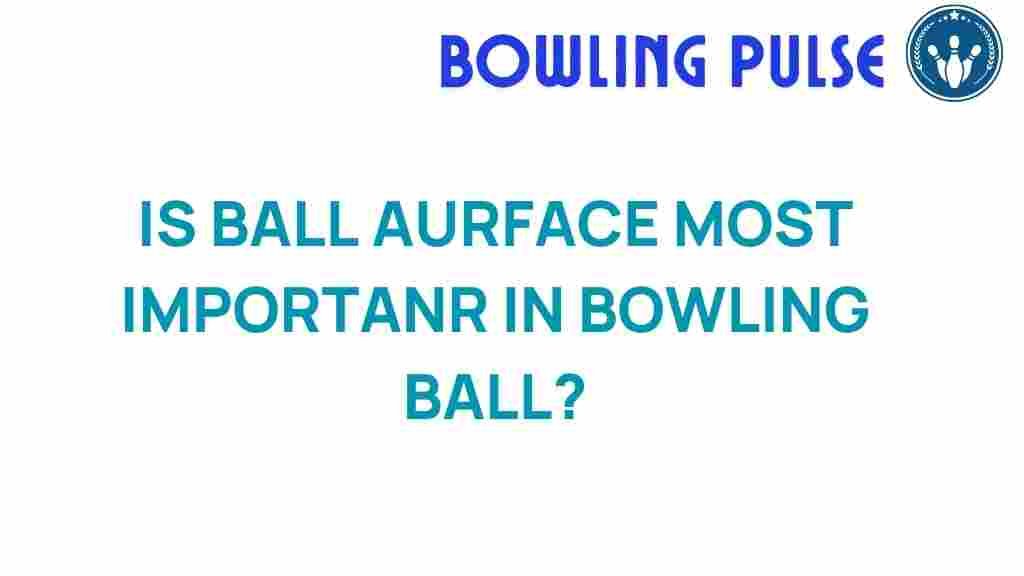Is Ball Surface the Key to Bowling Ball Performance?
When it comes to bowling, many factors influence the overall performance of a bowling ball. Among these, the ball surface stands out as a critical element that can dramatically affect your game. The surface of a bowling ball determines how it interacts with the lane conditions, the oil patterns, and ultimately, your technique. In this article, we will explore why the ball surface is essential for bowling ball performance and provide you with valuable tips to enhance your game.
Understanding Bowling Ball Surface
The surface of a bowling ball refers to its texture and finish. It can be smooth, rough, polished, or sanded, and each type of surface has unique characteristics that influence how the ball behaves on the lane. Here are the main types of bowling ball surfaces:
- Polished Surface: Provides a smoother finish that reduces friction, allowing the ball to glide more easily over the oil pattern.
- Sand Finished Surface: Offers more texture and grip, increasing friction with the lane and allowing for greater hook potential.
- Reactive Resin Surface: Offers a balance between polish and sanded finishes, providing both traction and control.
Each type of surface serves a different purpose and can significantly impact your bowling performance based on the lane conditions and your playing style.
How Ball Surface Affects Performance
The ball surface plays a pivotal role in determining how the bowling ball reacts when it hits the lane. Here’s how:
- Friction: The amount of friction created between the ball surface and the lane affects how much the ball hooks. A rough surface increases friction, leading to a stronger hook.
- Oil Patterns: Different oil patterns on the lane can dictate which ball surface to use. For example, on heavily oiled lanes, a polished ball might slide too much, while a sanded ball may grip too aggressively.
- Lane Conditions: The condition of the lanes, including how much oil is applied and where, will influence your choice of ball surface. Understanding these conditions can help you select the right ball for optimal performance.
Choosing the Right Ball Surface for Your Technique
Your bowling technique also plays a crucial role in how effective a particular ball surface will be. Here’s a step-by-step guide to choosing the right ball surface based on your technique:
- Assess Your Technique: Determine whether you have a high-rev, medium-rev, or low-rev technique. High-rev bowlers may benefit from smoother surfaces, while low-rev bowlers might prefer a more aggressive surface.
- Evaluate Lane Conditions: Spend time observing the oil patterns and lane conditions. If the lanes are dry, a polished ball might work best, while oiled lanes might require a sanded surface.
- Experiment: Try different ball surfaces during practice sessions. This will help you understand how each surface interacts with your technique and the lane conditions.
Tips for Maintaining Your Bowling Ball Surface
To ensure your bowling ball performs at its best, proper maintenance of the ball surface is vital. Here are some tips:
- Regular Cleaning: Clean your ball after every use to remove oil and dirt build-up. Use a microfiber towel and a bowling ball cleaner.
- Surface Adjustments: Periodically adjust the surface of your ball using sanding pads or polish to maintain the desired texture.
- Professional Resurfacing: Consider having your ball professionally resurfaced if it has significant wear and tear or if you want to change the surface type.
Troubleshooting Common Performance Issues
If you’re experiencing performance issues with your bowling ball, consider these troubleshooting tips:
- Inconsistent Hook: If your ball isn’t hooking as expected, check the surface texture. You may need to adjust it or change the ball entirely based on lane conditions.
- Ball Sliding Too Much: If your ball is sliding too much on oily lanes, consider using a ball with a rougher surface or sand it down slightly.
- Overreacting Ball: If the ball is hooking too much, especially on dry lanes, a polished surface might help reduce the friction.
Bowling Tips for Enhanced Performance
In addition to understanding your ball surface, here are some general bowling tips to improve your performance:
- Focus on Your Grip: A consistent grip is crucial for accuracy. Ensure your fingers fit snugly in the holes without being overly tight.
- Practice Your Approach: Work on your footwork and approach to maintain balance and power throughout your delivery.
- Observe Other Bowlers: Watch experienced bowlers to learn different techniques and how they handle various lane conditions.
For more detailed bowling techniques and tips, you can visit this comprehensive guide.
Conclusion
In summary, the ball surface is indeed a key factor in bowling ball performance. By understanding how different surfaces interact with lane conditions, oil patterns, and your unique technique, you can make informed decisions that enhance your game. Remember to maintain your bowling ball properly and experiment with different surfaces to find what works best for you. With the right knowledge and practice, you can elevate your bowling experience to new heights.
For more insights on bowling and other related topics, check out this resource.
This article is in the category Techniques and created by BowlingPulse Team
